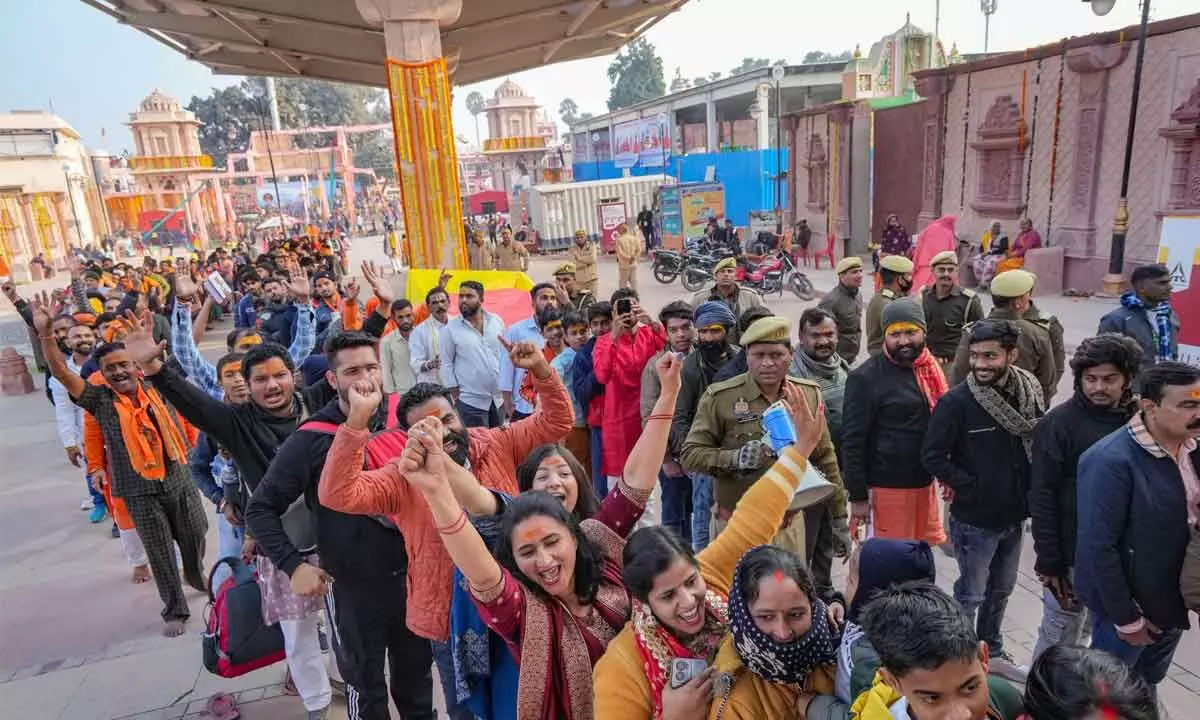It’s dawn of new mahakumb at Ayodhya!
Sadhu sanths, devotees from all quarters pour into holy city to witness consecration ceremony of Shri Ram mandir that brings curtain down on 500-yr timeline of uncertainty
image for illustrative purpose

Ramotsav
- Security checkups took over 2 hours
- QR code passes to all guests
- Devotees lining up on either side of Rampat
- Queue lines stretched over 5km
- However, it’s easing off after function
Ayodhya: As dawn broke over Ayodhya, a day after Pran Pratishtha, a sea of people, including seers, sadhus, and representatives from various ashrams and akharas, as well as individuals from different sectors -women and men, some who walked or cycled, and a few who performed thousands of sashtang pranam (where the whole body touches the ground) -young and old, dressed in their best attire, whether it be the bhagwa dress (Indian traditional dress in orange) or jeans and pants, descended onto the Ayodhya Dham with one wish in their hearts: to have the darshan of Ram Lalla. As one Ram bhakt rightly remarked, ‘Mahakumbh hai Ayodhya mein’ - it is the mahakumbh in Ayodhya.
For the consecration ceremony of Ram Lalla on January 22, the security arrangements to keep large crowds away included multiple layers of security, the blocking of lanes and bylanes leading to Rampat, restrictions on vehicular traffic into Ayodhya city from other cities, and access control based on QR code passes.
Despite all these measures, devotees displayed tireless devotion and determination, braving the weather and barriers, taking detours, and surmounting obstacles to assemble along Rampat. As the muhurta for the consecration ceremony neared, the whole atmosphere outside resonated with a festive spirit due to common devotees, underscoring their unique contribution to such gatherings.
On Tuesday, a day after the Pran Pratishtha, although the security restrictions within Ayodhya town have been slightly eased, allowing common people to approach the temple unlike on Monday, traffic from outside the city is still restricted, and train services to Ayodhya remain on hold.
For the past few days, the scene around the temple is abuzz with devotes connected with family and friends over WhatsApp group calls sharing the electrifying atmosphere. Amid diverse activities and perspectives, each person present had a unique reason for being part of this historic moment.
Waiting at the main gate to the temple, I heard people from Kerala, Rajasthan, Assam, Andhra Pradesh, and Tamil Nadu, sharing their views on everything from the past 500 years to the big day. One thing is clear: it is not just about what Babur did, nor is it about who contributed and who did not to the temple movement. For a common man on the street, it is about ‘aaj Bhagwan Ram Ayodhya mein Vapas Aaya hai’ (today Lord Ram has returned back to Ayodhya), said a daily wager from Bihar.
Shiv Kumar Sawlani, a readymade garment merchant, who has been selling readymade garments on Chowk Bajaja street in Ayodhya for over two decades, says, “Modi ji ne public ka dil hack kar diya” (Modi ji has hacked into people’s hearts), meaning he doesn’t need to hack EVMs.
Chanting ‘Ram Ram’ with utmost devotion and with folded hands, Kasipathi Sastri, who retired from LIC last year and hails from Andhra Pradesh, said: “Where else would one get to do darshan of hundreds of dharma gurus in one place?” Sastri reached the holy city to bask in the moment of Pran Pratishtha even from afar and he did not want to miss out on this once-in-a-lifetime opportunity. My takeaway from three days of interacting and being among the crowd in Ayodhya is that the ‘astha,’ or true depth of people’s faith in Lord Ram, becomes evident only when we engage with them in their authentic environment.
(The author is Founder of My Startup TV)

